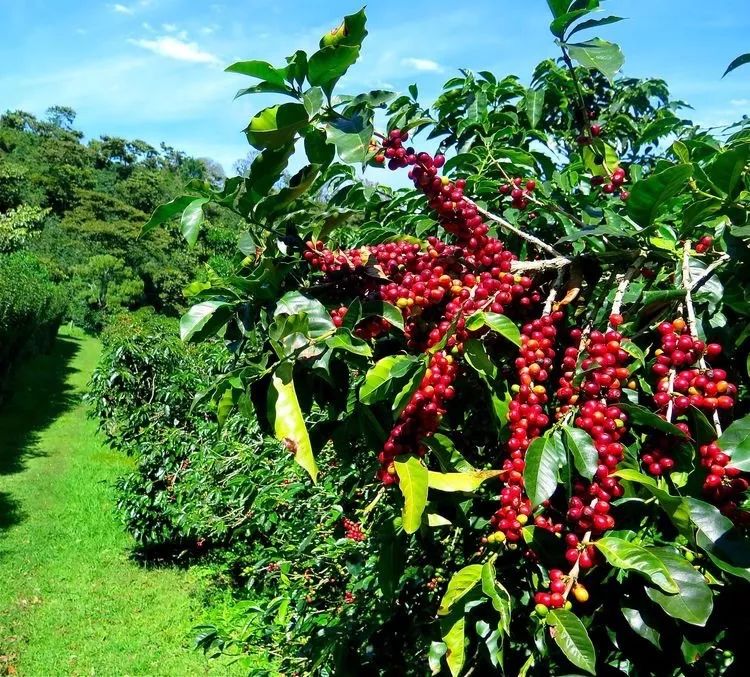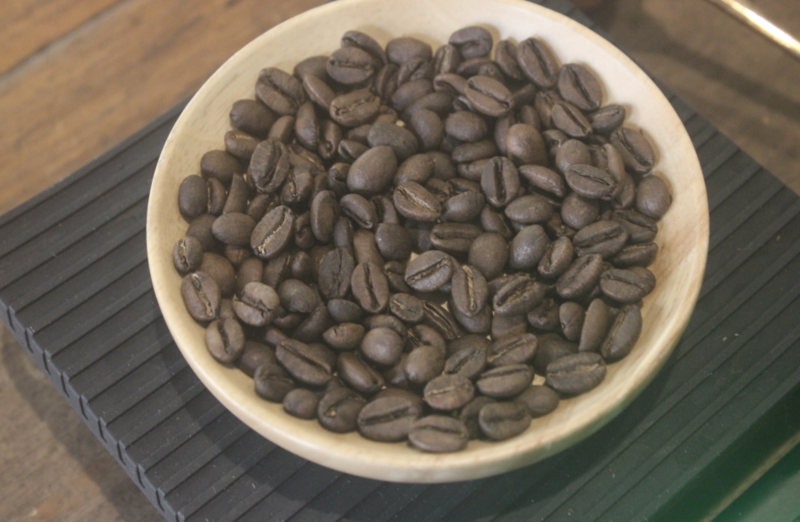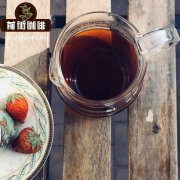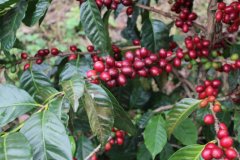What is Laurena's pointed bourbon? what is the flavor of the pointed bourbon coffee that was once extinct?
Professional coffee knowledge exchange more coffee bean information please follow the coffee workshop (Wechat official account cafe_style)
When it comes to decaf coffee, people basically think of decaf coffee that has been specially treated to reduce its caffeine. in fact, there is such a kind of coffee that is born with low caffeine content and only 0.5% caffeine content. That is the pointed bourbon that Qianjie Coffee is going to introduce to you today!

Pointed bourbon, academically called "Coffea Laurina" or Laurena coffee, but commonly known as pointed bourbon "Bourbon Pointu", this is because its beans are longer and narrower and slightly pointed at both ends, hence the name.
Why is the caffeine content of sharp body bourbon so low?
Unlike other artificially treated low-caffeine coffee, pointed bourbon is due to genetic degradation, resulting in lower caffeine content and better flavor than ordinary bourbon coffee trees, but extremely low yield. this is why pointed bourbon is rare and expensive. Pointed bourbon is particularly susceptible to leaf rust black spot, which is the main reason for its low yield. Because of this, pointed bourbon is so precious that it is mostly cultivated in the laboratory.

As early as the 18th century, pointed bourbon has been welcomed by the world, even King Louis XV of France, the famous novelist Balzac is its "fans"! During the two hundred years from the 18th century to the 19th century, pointed bourbon was widely planted on Bourbon Island, and its annual production reached a peak of 4,000 metric tons in 1800.
But then a series of disasters such as hurricanes, fire ants and leaf rust followed, and planting dwindled, and finally, in 1942, the last batch was shipped back to France, leaving only a pitiful 200 kilograms. Since then, the pointed bourbon has disappeared without a trace and is no longer mentioned in official documents. Pointed Bourbon was once extinct!

Decades after the sharp bourbon disappeared, Yoshihiro Kawashima, a coffee expert at UCC Coffee in Japan, repeatedly heard coffee farmers in El Salvador mention that "decaf trees may still live on the French bourbon island", giving him the idea of looking for the pointed bourbon.
So when he was on a trip to Africa in 1999, he stopped by the island of Bourbon to find the legendary decaf tree. However, things did not go as smoothly as expected. None of the young people on the island had heard of coffee crops in Bourbon, so they had to leave their contact address to local farmers and officials before leaving.

Finally, two years later, in 2001, Kawashima received a call from farmers on Bourbon Island, saying that more than 30 unknown coffee trees had been found in the wild.
Later, it was also identified by experts and confirmed to be the Bourbon pointed coffee tree at that time, so French scientists cooperated with Japan's Shangdao Coffee to launch a natural low-caffeine coffee tree restoration program. Finally, in 2006, there were a small number of bourbon pointed coffee beans, which were sold in 2007 after screening, but only for the Japanese market, the price is high, it is said to be four times more expensive than the top blue mountains!
At the 2018 World Coffee Brewing Competition, Emi Fukahori from Switzerland became another memorable chapter in coffee competition history by hammering over a group of Panamanian roses with a semi-carbon dioxide impregnated bourbon from Brazil.

The bean she chose at the time was a Laurina bourbon pointed body (or Bourbon Pointu) from Cerrado Region, Brazil's Daterra estate, and explained that this breed of coffee had 50% less caffeine and 20% chlorogenic acid than other Arabica varieties, so it tasted much less bitter. The flavors and aromas described by Emi Fukahori at that time were red grapes, orange blossoms, pineapples, lime and green apples. Ability to beat a lot of rosy summer, and finally won the WBrC crown, sharp body bourbon this breed can not be ignored.

The pointed bourbon coffee tree is similar to a small Christmas tree with short branches, narrow leaves and a caffeine content of only 0.5%. It is particularly easy to be infected with leaf rust, black spot, which is the main reason for its low yield, and the ripening period of red fruit is earlier than that of other varieties.
Although today's pointed bourbon is no longer as exaggerated as it was then, it is still a very precious bean, so what is the flavor of such an expensive pointed bourbon?

By observing the cooked beans, it can be seen that the whole particles of pointed bourbon coffee beans are small and symmetrical, and their beans are slender and pointed at both ends, similar to wheat.
Qianjie Coffee made a pot of sun-treated pointed bourbon coffee. The parameters and flavor are described as follows:
Parameters: 15 grams of powder, filter cup Hario V60, water temperature 89 ℃, medium and fine grinding, powder-water ratio close to 1:15.
Flushing and cooking technique: segmented extraction. Steaming with 29 grams of water, you can see that the surface of the powder bed changes from wet to dry, and the steaming time is 30 seconds; the water injection in the center of the small flow is divided into sections to 120 grams, and when you see that the liquid level drop is about to expose the powder bed, continue to inject water to 230 grams to stop, remove the filter cup when the liquid level drop is about to expose the powder bed, and the extraction time is 1: 45 ".

Flavor: dry aroma with fermented aromas, spices, nuts and tropical fruit aromas, wet aromas with obvious floral aromas, smooth palate, with red fruit, plum and pine nut flavors and long-lasting sucrose.
END
Important Notice :
前街咖啡 FrontStreet Coffee has moved to new addredd:
FrontStreet Coffee Address: 315,Donghua East Road,GuangZhou
Tel:020 38364473
- Prev

Do you want sugar in your coffee? what kind of sugar is appropriate?
Professional barista communication Please pay attention to the coffee workshop (Wechat official account cafe_style) Sugar can be divided into white sugar, brown sugar and yellow sugar according to color. The difference in color is due to the different degree of removal of impurities in the sugar-making process. White sugar is a refined sugar with a purity of more than 99%. Yellow sugar contains a small amount of minerals and organic matter, so it has color, while brown sugar is unrefined crude sugar.
- Next

Which one is good for Taobao coffee beans? 2019 A good shop recommendation for buying coffee beans on Taobao
Professional coffee knowledge exchange more coffee bean information Please follow the coffee workshop (Wechat official account cafe_style) the subjective feeling of drinking coffee is too important, do not be limited to the same shop, first drink more shops of the same origin and variety, choose the one that tastes most comfortable and the flavor description is most consistent with the subjective feeling, and then explore different varieties. Stores with high praise / high sales may not be in line with
Related
- What is the standard process for the purpose of coffee cup testing? What is the difference between hand-brewed coffee and cup testing?
- How to use hand-brewed coffee paragon small golden balls? How does cold coffee lock in the aroma of coffee?
- Is American coffee black? What is the difference between American coffee and drip coffee?
- Unexpected! Well-known tea beverage brand Lele Tea will withdraw from the Zhengzhou market!
- Starbucks enters the fashion and beauty industry?! Netizen: Give me an ice American eye cream
- Why can American refills for free? The difference between Americano and American drip pot coffee
- Being chased out of the rain in front of Starbucks?! Store: Sheltering from rain under umbrellas poses a safety hazard
- The white moonlight has changed?! Lucky launches "Big Winter Pear American"
- Hand-brewed coffee three-stage method, high-sweet and universal brewing method to share! What does the high sweet water level of hand-brewed coffee mean?
- What is the difference between raw, refined and full espresso coffee? How to extract espresso and taste good?

